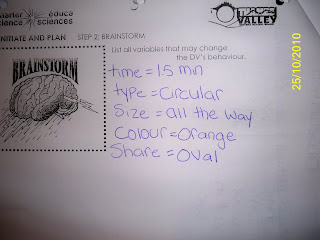I have been re-energized by attending a Smarter Science symposium over the weekend so today I facilitated an inquiry-based collaborative learning experience into electrostatic series with my grade nine applied class.
1. 1. Initiate and plan – ENGAGE
I began the class by modeling how a balloon holding static charge can be used to pick up pieces of confetti (the holes collected out of my hole-puncher). We drew on our previous knowledge, from last week’s classes, to determine how the balloon could be charged with static electricity.
I told the students that we were going to do an investigation to determine what material would produce the greatest static charge on the balloon. In the middle of the sun burst diagram we wrote: “What type of material will make the most static electricity?” This was our dependent variable.
We used the sun burst diagram to list all the different things that could observed while doing a lab.
These were:
1. The time spent rubbing

2. The type of rubbing
3. The shape of the balloon
4. The size of the balloon
5. The colour of the balloon
These items were listed on to little post it notes and stuck around the rays of the sun burst diagram.
We moved to page two of the sun burst diagram, to the Initiate and plan page, which has a picture of the brain and says “brainstorming” on in. Here we decided how we would control the variables that we had listed on our post it notes. This could have been done group-by-group but I chose to do it as a large group activity so everyone would be controlling variable in the same manner. Several excellent suggestions were made so we voted to decide which ones to go with. For example, the amount of time spent rubbing could have been 30 seconds, 60 seconds, 90 seconds, etc. All were good choices so I narrowed it down to the first four suggestions and we voted, by a show of hands. Thus, the controls were determined to be:
1. Time rubbing = 1.5 minutes
2. Type of rubbing = circular motion
3. Size of balloon = full capacity
4. Colour = orange (that’s what I had the most of)
5. Shape of balloon = oval
Now we moved all of our post it notes over to the fish bone diagram where they were taped down. I had actually forgotten that we should tape them  down at this point but the kids quickly reminded me.
down at this point but the kids quickly reminded me.
2. Perform and Record = EXPLORE
The students designed an observation table by drawing a simple t-chart. On the left side they wrote “type of material” and on the right side they wrote ‘number of pieces of confetti collected”. Working in pairs they performed the investigation and were incredibly intr4igued by it. It made me realize how much of the sense of wonder grade nine students still have in them.
Some of the comments I heard during the lab were:
“I can hear the static electricity!”
“Listen!”
“You can hear it crackling!”
“Don’t forget to discharge between tests.”
“Make sure you rub in little circles.”
“It’s your turn to time while I rub.”
“Let’s split the amount of confetti pieces we have to count and each count half of them then add our two answers together.”
3. Analyze and Interpret = EXPLAIN
After testing a variety of materials, such as wool, silk, hair, fur and plastic the students were able to analyze their data to determine which materials created the most static and which created the least. At this stage I introduced them to the concept of “Electrostatic Series” with a very simple definition of “ a list of materials from the most static to the least static”.
4. Communicate = EXTEND
Each student created an electrostatic series by listing the materials they tested, in order, from those that created a static charge to those that created the least. They were able to quantify their results because they had counted the number of pieces of confetti that was attracted to the balloon during each test.
